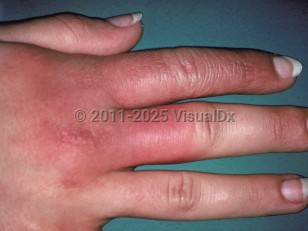Erysipeloid
See also in: Cellulitis DDxAlerts and Notices
Important News & Links
Synopsis

Erysipeloid is an infection of the skin caused by the gram-positive bacillus Erysipelothrix rhusiopathiae. The bacterium is transmitted when traumatized human skin comes into contact with an infected animal or animal meat; therefore, farmers, cooks, butchers, and fishermen are most at risk. Erysipeloid is transmitted by several animals, particularly pigs, but also sheep, rabbits, chickens, turkeys, ducks, emus, scorpion fish, and lobsters. The disease is rare in children.
Erysipeloid is characterized by erythematous to violaceous well-defined plaques with edema and raised borders. Vesicles, bullae, and erosions can also be present. The lesions of erysipeloid are generally located on the back of the hands and/or fingers. They are most often asymptomatic, but some patients may report mild pain, pruritus, or fever.
The diffuse / generalized form is rare and is characterized by similar cutaneous lesions in a widespread distribution. Unlike localized erysipeloid, patients with the diffuse / generalized form often report fever, lymphadenitis, and arthralgias.
In addition to the localized and diffuse cutaneous disease detailed above, the bacterium can also cause systemic disease, most often in the form of acute or subacute endocarditis. Endocarditis is rare and usually affects previously damaged valves.
The lesions of localized cutaneous erysipeloid often resolve without treatment in 3-4 weeks but may recur. Therefore, treatment with antibiotics is indicated in all forms of erysipeloid.
Erysipeloid is characterized by erythematous to violaceous well-defined plaques with edema and raised borders. Vesicles, bullae, and erosions can also be present. The lesions of erysipeloid are generally located on the back of the hands and/or fingers. They are most often asymptomatic, but some patients may report mild pain, pruritus, or fever.
The diffuse / generalized form is rare and is characterized by similar cutaneous lesions in a widespread distribution. Unlike localized erysipeloid, patients with the diffuse / generalized form often report fever, lymphadenitis, and arthralgias.
In addition to the localized and diffuse cutaneous disease detailed above, the bacterium can also cause systemic disease, most often in the form of acute or subacute endocarditis. Endocarditis is rare and usually affects previously damaged valves.
The lesions of localized cutaneous erysipeloid often resolve without treatment in 3-4 weeks but may recur. Therefore, treatment with antibiotics is indicated in all forms of erysipeloid.
Codes
ICD10CM:
A26.0 – Cutaneous erysipeloid
SNOMEDCT:
400105005 – Erysipeloid
A26.0 – Cutaneous erysipeloid
SNOMEDCT:
400105005 – Erysipeloid
Look For
Subscription Required
Diagnostic Pearls
Subscription Required
Differential Diagnosis & Pitfalls

To perform a comparison, select diagnoses from the classic differential
Subscription Required
Best Tests
Subscription Required
Management Pearls
Subscription Required
Therapy
Subscription Required
References
Subscription Required
Last Reviewed:06/18/2018
Last Updated:06/18/2018
Last Updated:06/18/2018
Erysipeloid
See also in: Cellulitis DDx
